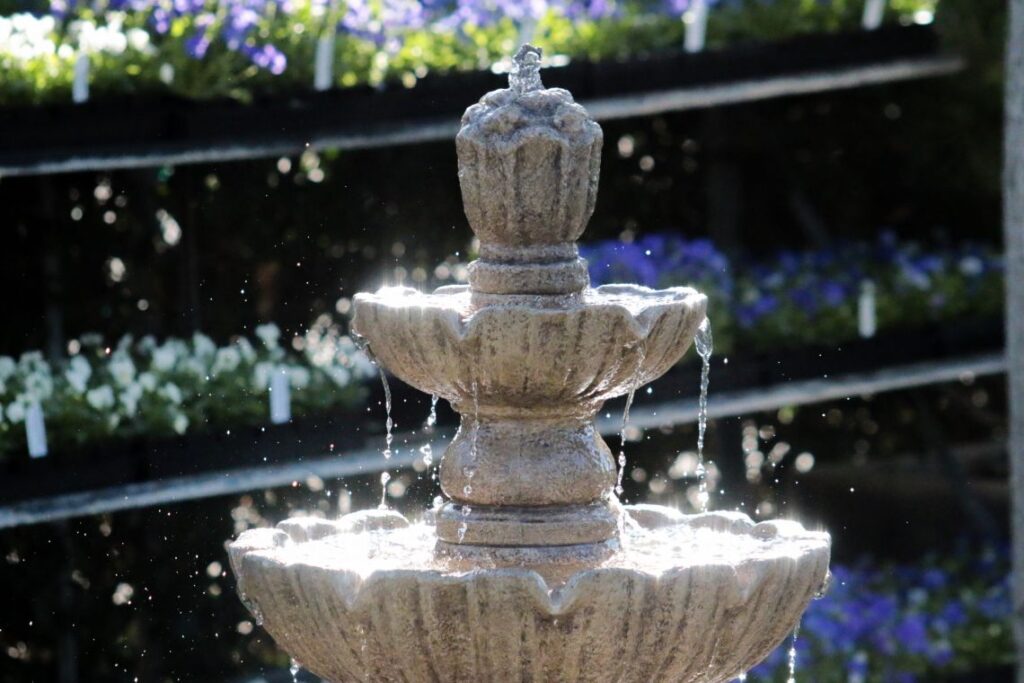Adding a water feature to your garden is a fantastic way to create a serene and visually captivating environment. Water features, ranging from simple birdbaths and fountains to larger ponds and waterfalls, provide aesthetic and ecological benefits to your garden space. Below, we cover the key steps for preparing your garden for a water feature and the various benefits they offer.
Preparation for Adding a Water Feature
1. Determine the Type of Water Feature
- Fountains: Fountains are versatile and come in a variety of sizes, from small wall-mounted features to large, freestanding structures.
- Ponds: Ponds provide a naturalistic look and can support aquatic plants and wildlife, such as fish and amphibians.
- Waterfalls: Waterfalls create movement and sound, adding a dynamic element to the garden.
- Birdbaths: These smaller features attract birds and provide a focal point for small gardens.
2. Choose the Right Location
- Sunlight and Shade: The location of the water feature should balance sunlight and shade. If you plan to include aquatic plants or fish, aim for partial sunlight to prevent the water from overheating while still supporting plant growth.
- Visibility: Place the water feature where it can be easily viewed from patios, decks, or garden seating areas. This maximizes enjoyment and aesthetic impact.
- Water Access: Ensure your water feature is close to a water source for easy refilling and maintenance.
3. Prepare the Ground
- Level the Ground: The ground must be level to support the structure of a fountain, pond, or waterfall. Use a spirit level to ensure stability.
- Excavation: For ponds or larger water features, excavation is necessary. Determine the depth and shape of the pond, keeping in mind the desired plants and fish. Install a pond liner to prevent water loss.
4. Install Electrical Components
- Pump Installation: Most water features require a pump to circulate water. Ensure the pump is properly sized for the feature, whether it’s a small fountain or a large pond. Larger features might require an external filter and UV clarifier for water quality.
- GFCI Outlet: If the water feature requires electricity, ensure that the power source is protected by a Ground Fault Circuit Interrupter (GFCI) outlet for safety.
5. Add Plants and Accessories
- Aquatic Plants: Plants like water lilies, lotus, and cattails are ideal for ponds, while smaller water features can include floating plants like duckweed.
- Rocks and Stones: Adding rocks around the edges of a pond or waterfall can create a more natural, integrated look and help stabilize the structure.

Benefits of Adding a Water Feature
1. Aesthetic Appeal
- Visual Impact: Water features serve as a stunning focal point in the garden. Whether you choose a tranquil pond, a sparkling fountain, or a cascading waterfall, the movement and reflection of water create dynamic visual interest.
- Complementary to Design: Water features can enhance different garden styles, from formal landscapes with geometric fountains to naturalistic gardens with rustic ponds and stone waterfalls.
2. Enhancing Relaxation and Well-Being
- Calming Effect: The sound of running water has a calming, meditative effect, reducing stress and promoting relaxation. The gentle sound of a fountain or waterfall can help mask noise from traffic or neighbors, creating a peaceful retreat in your garden.
- Connection with Nature: Water features attract wildlife like birds, butterflies, and frogs, helping you feel closer to nature. Birdbaths, for example, bring birds to your garden for a drink or a quick bath, adding life and movement to the space.
3. Supporting Biodiversity
- Wildlife Habitat: Ponds, in particular, create a habitat for a variety of species, including frogs, dragonflies, and fish. Aquatic plants also provide food and shelter for wildlife. Even small water features like birdbaths or fountains can help support birds and pollinators.
- Pollination: Bees, butterflies, and other pollinators benefit from a water source in the garden. They use the water to cool themselves and regulate temperature, especially during hot summer days.
4. Improving Air Quality and Humidity
- Natural Humidifier: Water features release moisture into the air, which can help improve air quality and increase humidity levels, especially beneficial in dry climates.
- Cooling Effect: Large water features, like ponds, can help cool the surrounding air during hot summer months, making the garden more comfortable.
5. Increasing Property Value
- Boost Curb Appeal: A well-designed water feature enhances the overall appearance of your garden, which can increase your property’s curb appeal. Prospective buyers often see water features as a desirable landscape element, adding value to your home.
Conclusion
Adding a water feature to your garden creates a relaxing, beautiful, and eco-friendly space that offers both aesthetic and practical benefits. Whether you opt for a simple birdbath or an elaborate pond, taking the time to properly prepare and install the feature will reward you with years of enjoyment. By enhancing biodiversity, improving relaxation, and increasing property value, water features can transform your garden into a serene oasis.
Need Assistance? Contact Us at Green Hills Nursery
If you’re considering adding a water feature to your garden, let the experts at Green Hills Nursery guide you through the process. From selecting the right feature for your space to helping you with installation and plant selection, we offer personalized advice to make your garden vision a reality. Contact us today or visit our store for more information!




